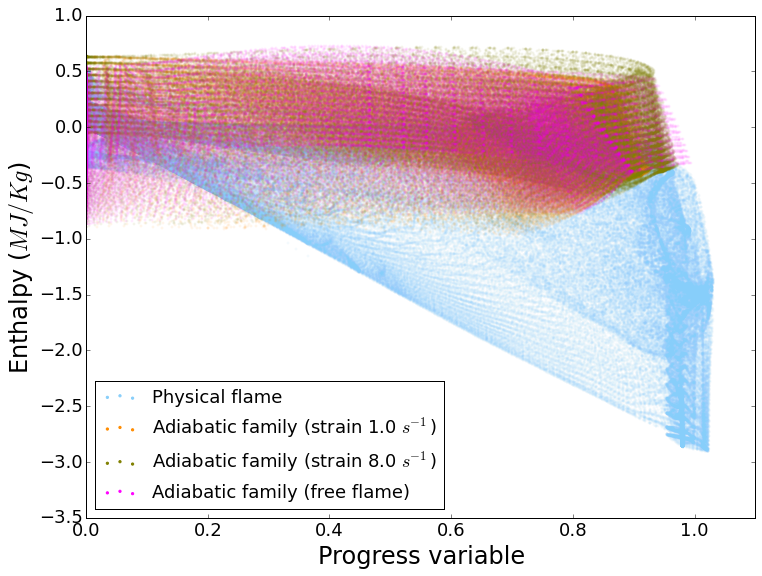Project Description
The use of detailed chemical models for the numerical simulation of combustion is computationally very expensive. In order to decrease the effort needed, different techniques have emerged in the last decades, and currently continue to be developed.
The Flamelet-Generated Manifolds (FGM) method is one of such techniques, which has been used to model both laminar and turbulent combustion. This method assumes that the thermochemical space accessed in a real flame is confined to a low-dimensional subspace, which can be represented by one-dimensional flames, referred to as flamelets.
Essentially, the method consists in solving a set of flamelets and storing the in- formation obtained in a low-dimensional manifold, as a function of a number of controlling variables. Then, in the simulation of the combusting flow of interest, a set of transport equations are solved for these controlling variables, and their local values are used to retrieve the complete thermochemical state from the manifold.
This thesis presents some improvements developed for the FGM model, which al-low to solve partially-premixed, non-adiabatic flames in complex configurations. The model has been implemented in a CFD solver, including the radiation effects and conjugate heat transfer. Although this work focuses on laminar combustion, the method and the developments presented are also applicable to turbulent combustion flows.
The key to the success in the use of FGM is the thorough exploration of the thermochemical space accessed in a three-dimensional flame by means of simple, one- dimensional flamelet configurations. Several strategies have been developed, each of them aimed at accessing a specific part of the composition space. Typically over half a million states are calculated, which represent most of the thermochemical space accessed by the real flame.
A methodology has been developed to manipulate and store this cloud of unstructured data as a function of a generic number of dimensions, while allowing a fast retrieval during the simulation. A three-dimensional manifold has been used for the reference simulations and analysis in this thesis. However, if all the previously accessed points are stored in the three-dimensional manifold, multivaluation occurs; that is to say, the relation between the thermochemical states and the three controlling variables is not bijective. To avoid multivaluation, which may have deleterious effects on the calculation, the sets of points used to build the three- dimensional manifolds have to be carefully chosen. To help with multivaluation, and to provide access to a wider region of the composition space, an extension to four-dimensional manifolds has been implemented and tested, showing an improvement in the results.
The configurations studied are methane-air systems. A 16-species reduced chemical mechanism is used as reference, and a 49-species detailed mechanism has also been used for comparison. Two configurations have been simulated: a simple, 2D, laboratory flame, and a real, 3D, comercial domestic-cooker burner. The results obtained for both configurations show a good agreement with those from the direct integration of the chemistry, and the discrepancies found are of the same order as those encountered when comparing the detailed and the reduced mechanisms.
A sensitivity analysis has been performed to study the influence of the main model parameters. The inclusion of the multicomponent diffusion effects in the enthalpy transport equation results in minor improvements in a configuration with parallel inlet flows, while in a more complex flame the effects are negligible. The definition of the progress variable has a limited influence, and the one providing overall better results has been used for the reference case. The set of values chosen to build the three-dimensional manifold determine which areas of the composition space are accessed, and the topology of the manifold itself.
To overcome the limitations of the three-dimensional manifolds, the use of an ad- ditional controlling variable has been proposed. The additional dimension unfolds the composition space and removes the multivaluation even if the complete set of flamelets is stored. In this new framework, the composition space accessed in a real flame is better represented, leading to improved results.
Using the FGM model implemented, the computational effort that is needed to perform a simulation of a 3D, complex flame is reduced by a factor of 20 when compared with the direct integration of a reduced chemical mechanism combined with In-Situ Adaptive Tabulation (ISAT). If compared with the direct integration of the detailed mechanism for methane without ISAT, the cost is then reduced between three and four orders of magnitude. In the implementation performed in this work, the computational cost is affected by the chemical mechanism and the dimensionality of the manifold, regarding the calculation of the flamelets and the manifold construction. Their influence on the simulation run-time, though, is very small.

